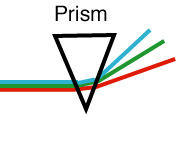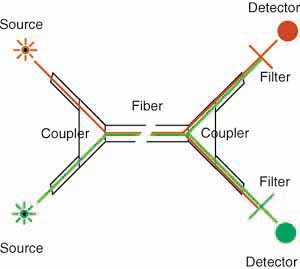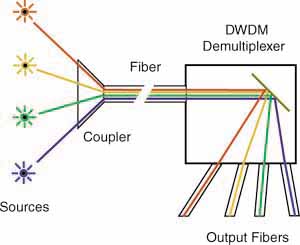10Base-T A Physical layer standard for
networks that specifies baseband transmission, twisted pair media, and 10-Mbps
throughput. 10Base-T networks have a maximum segment length of 100 meters and
rely on a star topology.
10GBase-ER A Physical layer standard
for achieving 10-Gbps data transmission over single-mode, fiber-optic cable. In
10GBase-ER, the ER stands for extended reach. This standard specifies a star
topology and segment lengths up to 40,000 meters.
10GBase-EW A variation of the
10GBase-ER standard that is specially encoded to operate over SONET links.
10GBase-LR A Physical layer standard
for achieving 10-Gbps data transmission over single-mode, fiber-optic cable
using wavelengths of 1310 nanometers. In 10GBase-LR, the LR stands for long
reach. This standard specifies a star topology and segment lengths up to 10,000
meters.
10GBase-LW A variation of the
10GBase-LR standard that is specially encoded to operate over SONET links.
10GBase-SR A Physical layer standard
for achieving 10-Gbps data transmission over multimode fiber using wavelengths
of 850 nanometers. The maximum segment length for 10GBase-SR can reach up to
300 meters, depending on the fiber core diameter and modal bandwidth used.
10GBase-SW A variation of the
10GBase-SR standard that is specially encoded to operate over SONET links.
10GBase-T A Physical layer standard for
achieving 10-Gbps data transmission over twisted pair cable. Described in its
2006 standard 802.3an, IEEE specifies Cat 6 or Cat 7 cable as the appropriate
medium for 10GBase-T. The maximum segment length for 10GBase-T is 100 meters.
100Base-FX A Physical layer standard
for networks that specifies baseband transmission, multimode fiber cabling, and
100-Mbps throughput. 100Base-FX networks have a maximum segment length of 2000
meters. 100Base-FX may also be called Fast Ethernet.
100Base-T A Physical layer standard for
networks that specifies baseband transmission, twisted pair cabling, and
100-Mbps throughput. 100Base-T networks have a maximum segment length of 100
meters and use the star topology. 100Base-T is also known as Fast Ethernet.
100Base-TX A type of 100Base-T network
that uses two wire pairs in a twisted pair cable, but uses faster signaling to
achieve 100-Mbps throughput. It is capable of full-duplex transmission and
requires Cat 5 or better twisted pair media.
1000Base-LX A Physical layer standard
for networks that specifies 1-Gbps transmission over fiber-optic cable using
baseband transmission. 1000Base-LX can run on either single-mode or multimode
fiber. The LX represents its reliance on long wavelengths of 1300 nanometers. 1000Base-LX
can extend to 5000-meter segment lengths using single-mode, fiber-optic cable. 1000Base-LX
networks can use one repeater between segments.
1000Base-SX A Physical layer standard
for networks that specifies 1-Gbps transmission over fiber-optic cable using
baseband transmission. 1000Base-SX runs on multimode fiber. Its maximum segment
length is 550 meters. The SX represents its reliance on short wavelengths of
850 nanometers. 1000Base-SX can use one repeater.
1000Base-T A Physical layer standard
for achieving 1 Gbps over UTP. 1000Base-T achieves its higher throughput by
using all four pairs of wires in a Cat 5 or better twisted pair cable to both
transmit and receive signals. 1000Base-T also uses a different data encoding
scheme than that used by other UTP Physical layer specifications.
5-4-3 rule A guideline for 10-Mbps
Ethernet networks stating that between two communicating nodes, the network
cannot contain more than five network segments connected by four repeating
devices, and no more than three of the segments may be populated.
802.3ab The IEEE standard that
describes 1000Base-T, a 1-gigabit Ethernet technology that runs over four pairs
of Cat 5 or better cable.
802.3ae The IEEE standard that
describes 10-gigabit Ethernet technologies, including 10GBase-SR, 10GBase-SW,
10GBase-LR, 10GBase-LW, 10GBase-ER, and 10GBase-EW.
802.3af The IEEE standard that
specifies a way of supplying electrical Power over Ethernet (PoE). 802.3af
requires Cat 5 or better UTP or STP cabling and uses power sourcing equipment
to supply current over a wire pair to powered devices. PoE is compatible with existing
10Base-T, 100Base-TX, 1000Base-T, and 10GBase-T implementations.
802.3an The IEEE standard that
describes 10GBase-T, a 10-Gbps Ethernet technology that runs on Cat 6 or Cat 7
twisted pair cable.
802.3u The IEEE standard that describes
Fast Ethernet technologies, including 100Base-TX.
802.3z The IEEE standard that describes
1000Base (or 1-gigabit) Ethernet technologies, including 1000Base-LX and
1000Base-SX.
access method A network’s method of
controlling how nodes access the communications channel. For example, CSMA/CD
(Carrier Sense Multiple Access with Collision Detection) is the access method
specified in the IEEE 802.3 (Ethernet) standard.
active topology A topology in which
each workstation participates in transmitting data over the network. A ring
topology is considered an active topology.
broadcast domain Logically grouped
network nodes that can communicate directly via broadcast transmissions. By
default, switches and repeating devices such as hubs extend broadcast domains.
Routers and other Layer 3 devices separate broadcast domains.
bus The single cable connecting all
devices in a bus topology.
bus topology A topology in which a
single cable connects all nodes on a network without intervening connectivity
devices.
Carrier Ethernet A level of Ethernet
service that is characterized by very high throughput and reliability and is
used between carriers, such as NSPs.
Carrier Sense Multiple Access with
Collision Detection See CSMA/CD.
circuit switching A type of switching
in which a connection is established between two network nodes before they
begin transmitting data. Bandwidth is dedicated to this connection and remains
available until users terminate the communication between the two nodes.
collapsed backbone A type of backbone
that uses a router or switch as the single central connection point for
multiple subnetworks.
collision In Ethernet networks, the
interference of one node’s data transmission with the data transmission of
another node sharing the same segment.
collision domain The portion of an
Ethernet network in which collisions could occur if two nodes transmit data at
the same time. Switches and routers separate collision domains.
CSMA/CD (Carrier Sense Multiple Access with
Collision Detection) A network access method specified for use by IEEE
802.3 (Ethernet) networks. In CSMA/CD, each node waits its turn before
transmitting data to avoid interfering with other nodes’ transmissions. If a node’s
NIC determines that its data have been involved in a collision, it immediately
stops transmitting. Next, in a process called jamming, the NIC issues a special
32-bit sequence that indicates to the rest of the network nodes that its
previous transmission was faulty and that those data frames are invalid. After
waiting, the NIC determines if the line is again available; if it is available,
the NIC retransmits its data.
daisy chain A group of connectivity
devices linked together in a serial fashion.
data propagation delay The length of
time data take to travel from one point on the segment to another point. On
Ethernet networks, CSMA/CD’s collision detection routine cannot operate
accurately if the data propagation delay is too long.
distributed backbone A type of backbone
in which a number of intermediate connectivity devices are connected to one or
more central connectivity devices, such switches or routers, in a hierarchy.
enterprise An entire organization,
including local and remote offices, a mixture of computer systems, and a number
of departments. Enterprise-wide computing takes into account the breadth and
diversity of a large organization’s computer needs.
Ethernet II The original Ethernet frame
type developed by Digital Equipment Corporation, Intel, and Xerox, before the
IEEE began to standardize Ethernet. Ethernet II is distinguished from other
Ethernet frame types in that it contains a 2-byte type field to identify the
upper-layer protocol contained in the frame. It supports TCP/IP and other
higher-layer protocols.
Fast Ethernet A type of Ethernet
network that is capable of 100-Mbps throughput. 100Base-T and 100Base-FX are
both examples of Fast Ethernet.
fault tolerance The capability for a
component or system to continue functioning despite damage or malfunction.
Gigabit Ethernet A type of Ethernet
network that is capable of 1000-Mbps, or 1-Gbps, throughput.
hybrid topology A physical topology
that combines characteristics of more than one simple physical topology.
jamming A part of CSMA/CD in which,
upon detecting a collision, a station issues a special 32-bit sequence to
indicate to all nodes on an Ethernet segment that its previously transmitted
frame has suffered a collision and should be considered faulty.
logical topology A characteristic of
network transmission that reflects the way in which data are transmitted
between nodes. A network’s logical topology may differ from its
physical topology. The most common
logical topologies are bus and ring.
MPLS (multiprotocol label switching) A
type of switching that enables any one of several Layer 2 protocols to carry
multiple types of Layer 3 protocols. One of its benefits is the ability to use
packet-switched technologies over traditionally circuit-switched networks. MPLS
can also create end-to-end paths that act like circuit-switched connections.
modal bandwidth A measure of the
highest frequency of signal a multimode fiber-optic cable can support over a
specific distance. Modal bandwidth is measured in MHz-km.
multiprotocol label switching See MPLS.
packet switching A type of switching in
which data are broken into packets before being transported. In packet
switching, packets can travel any path on the network to their destination because
each packet contains a destination address and sequencing information.
padding The bytes added to the data (or
information) portion of an Ethernet frame to ensure this field is at least 46
bytes in size. Padding has no effect on the data carried by the frame.
parallel backbone A type of backbone
that consists of more than one connection from the central router or switch to
each network segment.
passive topology A network topology in
which each node passively listens for, then accepts, data directed to it. A bus
topology is considered a passive topology.
PD (powered device) On a network using
Power over Ethernet, a node that receives power from power sourcing equipment.
physical topology The physical layout
of the media, nodes, and devices on a network. A physical topology does not
specify device types, connectivity methods, or addressing schemes. Physical
topologies are categorized into three fundamental shapes: bus, ring, and star.
These shapes can be mixed to create hybrid topologies.
PoE (Power over Ethernet) A method of
delivering current to devices using Ethernet connection cables.
Power over Ethernet See PoE.
power sourcing equipment See PSE.
powered device See PD.
preamble The field in an Ethernet frame
that signals to the receiving node that data are incoming and indicates when
the data flow is about to begin.
PSE (power sourcing equipment) On a
network using Power over Ethernet, the device that supplies power to end nodes.
QoS (quality of service) The result of
specifications for guaranteeing data delivery within a certain period of time
after their transmission.
quality of service See QoS.
ring topology A network layout in which
each node is connected to the two nearest nodes so that the entire network
forms a circle. Data are transmitted in one direction around the ring. Each
workstation accepts and responds to packets addressed to it, then forwards the other
packets to the next workstation in the ring.
serial backbone A type of backbone that
consists of two or more internetworking devices connected to each other by a
single cable in a daisy chain.
SFD (start-of-frame delimiter) A 1-byte
field that indicates where the data field begins in an Ethernet frame.
signal bounce A phenomenon, caused by
improper termination on a bus-topology network, in which signals travel
endlessly between the two ends of the network, preventing new signals from
getting through.
star topology A physical topology in
which every node on the network is connected through a central connectivity
device. Any single physical wire on a star network connects only two devices,
so a cabling problem will affect only two nodes. Nodes transmit data to the
device, which then retransmits the data to the rest of the network segment
where the destination node can pick it up.
star-wired bus topology A hybrid
topology in which groups of workstations are connected in a star fashion to
connectivity devices that are networked via a single bus.
star-wired ring topology A hybrid
topology that uses the physical layout of a star and the token-passing data
transmission method.
start-of-frame delimiter See SFD.
switching A component of a network’s
logical topology that manages how packets are filtered and forwarded between
nodes on the network.
terminator A resistor that is attached
to each end of a bus-topology network and that causes the signal to stop rather
than reflect back toward its source.



